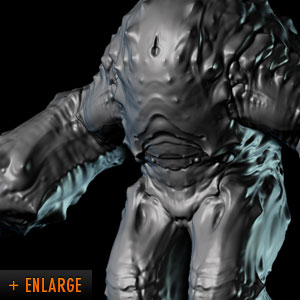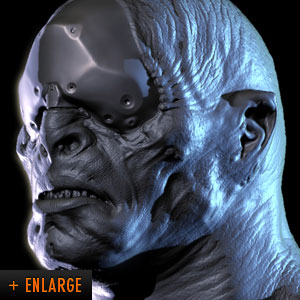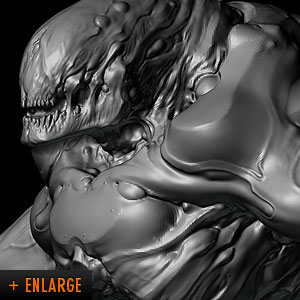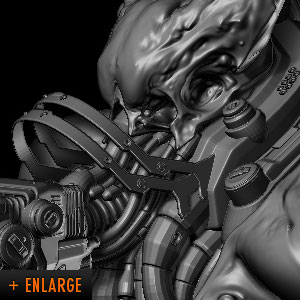
Kenneth on ZBrush and the fascinating world of gaming. Kenneth is an art director at Id Software and one of the extremely talented artists behind Doom 3. In this interview, Kenneth shares his joy of ZBrush as an artist's tool and how to integrate ZBrush into a next-generation games pipeline.
Let's get started with the basics. What do you do at Id Software?
I was the art director for DOOM 3, and will continue in that role on our next project. I also handle the bulk of our character and monster modeling. Personally, I don't believe there can be a management substitute for talent. Our games look good only because Id is populated with some of the best artists in the industry. I'm proud to share office air with these guys and glad they put up with me. :)
You have a background in illustration, right? What landed you in the middle of Hades creating demons for Id?
It's an exciting field - different in so many ways from other narrative forms of entertainment. It has a lot of the same appeal both comics and films have, but with this additional element of interactivity. It really is a new frontier in storytelling.

What job did you have before Id?
I was a freelance artist/illustrator - sort of a euphemism for near unemployed.
Do you still oil paint?
Unfortunately, no. Time and my deepening dependence on 'undo' have kept me firmly in the digital realm. I recently managed to get a few ZBrush models rapid prototyped, so even my Sculpy is gathering dust. I still hit the pencil on a near daily basis though. Interestingly enough, I think my background as a painter was more applicable to ZBrush than all the 3d modeling I have done.
How long have you been using ZBrush?
If memory and this registration email here serves correctly, since April 2004. :) We didn’t start using it in production until 2.0 came out, but managed in a few short months with it to revisit a few key characters and completely overhaul DOOM 3's hell levels. It also became my principal tool in helping Nerve Software (a development partner of ours) with their character needs for the DOOM 3: Resurrection of Evil Expansion Pack. Now I get all crabby if I have to touch another 3d app. :)
What first got you interested in ZBrush?
Seeing the work that was coming out of the 2.0 Beta, and particularly the images floating around from WETA and Dave Cardwell, is what initially grabbed my attention. It was generations beyond the organic modeling other applications were doing at the time. Actually using ZBrush is what got me hooked. It allowed us to reach previously unattainable natural detail better and faster than really ought to be possible. I'm still convinced there's a little sorcery at work...

Can you describe your workflow for creating such cool creatures for those who may not be familiar with a Games pipeline?
I imagine it's fairly typical. I will create a quick low-poly shape in another 3d app, in the neighborhood of 300 to 1000 quads. The focus is usually to keep the quad size consistent throughout the model. These days I do most of my character composition in ZBrush. Editing outside of ZBrush is restricted mostly to maintaining world proportion within our engine, and in the case of humans, respecting pre-existing animation rigs. I'll bounce back and fourth between apps until I'm comfortable I've made correct decisions about topology and tessellation, and then begin sculpting “general to specific” while creeping up subdivisions. One of the breaths of fresh air about this tool is how fast work can develop, where a lot of conceptual design can quickly happen inside the actual process.
It's painless to try different proportions and compositions without having to undo hours of pulling points and splines. I usually end up in the 3-4 million polygon neighborhood for a full, contiguous organic creature. This model is only used to derive the normal map, using our in-engine tool, so it's only goal is to be as cool and as detailed as my machine can handle. :) The in-game model is typically a collage of lower subdivision exports from ZBrush, decimations and hand modeling. The divorce between the two has some nice benefits: decisions I make about deformation and joints in the in-game model don't need to be dictated by the high-res, and I'm free from having to texture and UV the high-res model. Following the completion of the low poly model, I simply run DOOM 3 and execute our normal mapping tool from the console. Soon after, I have a pretty good approximation of the high-res mesh in real time manageable format. Yay!
"I'd quite honestly be frightened to make another game with a contemporary graphics renderer without ZBrush"
How has ZBrush affected this workflow?
The additional time overhead of building high-res content for games was cut back down to a manageable and practical size in a lot of circumstances. I'd quite honestly be frightened to make another game with a contemporary graphics renderer without ZBrush.

What are the distinct advantages of using ZBrush in a Game studio pipeline?
It's a substantial time saver with organic modeling, and it's really set the bar high for the quality and detail we're now capable of. Most recently we've been exploiting the tool in doing some terrain generation. Visually, it’s a vast improvement over height mapped terrain, and it's faster and more immediate than tweaking displacement maps. Massive changes can be implemented in seconds with a few quick yanks of the move tool.
You’ve got a great variety of mechanical and organic qualities in your model. What tools or techniques can you share with us that you have found most beneficial to you?
To get harder edges on semi-industrial surfaces I'll usually build up the edge line and smooth on either side of it until it gets crisp. It's not really precise, but it does have the added benefit of natural imperfections.
Having integrated ZBrush into the pipeline at Id, what advice can you give to studios looking to do the same?
There weren't a lot of hurdles to overcome other than the initial adaptation to the tool - it plugged in pretty painlessly and I frequently find new uses for it. One issue we had to address occasionally was juggling the final geometry after export - my polygon counts would at times get beyond what my machine was capable of. Also, the orthographic workspace in ZBrush can sometimes yield unpredictable results when geometry is moved into another app or renderer. If you're doing human characters especially, I would suggest starting your heads in an app that has a perspective view and then finish in ZBrush. I've been using the Mac version of ZBrush for about a month to take advantage of its perspective tools, and it has solved all of these issues. I can't wait for the PC update. :)
Thank you Kenneth for taking the time to answer our questions. We really appreciate the cool work that you do!
Wait until you see the stuff we can’t show you. :) A big thanks to everybody at Pixologic for this amazing tool, I can’t imagine making games without it!


